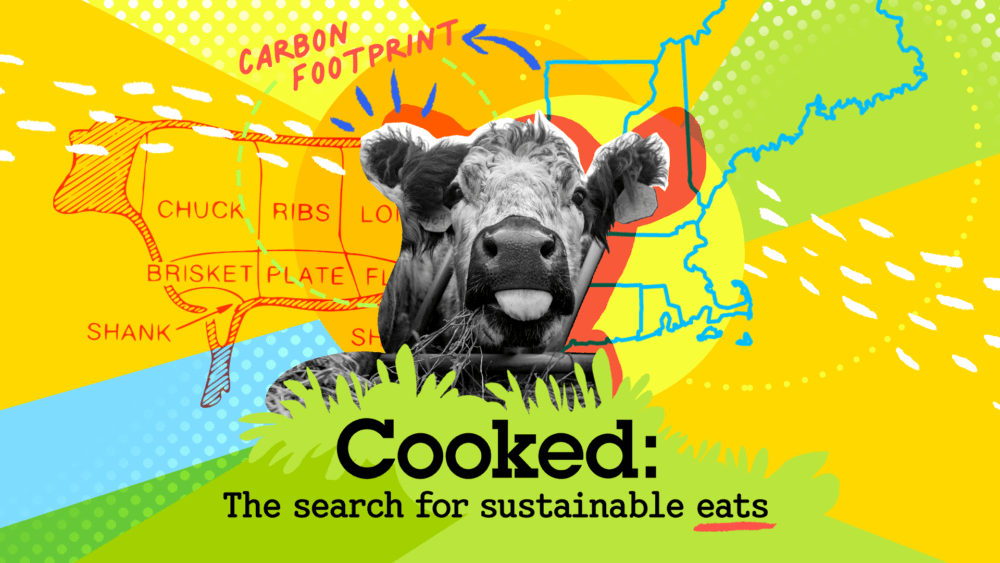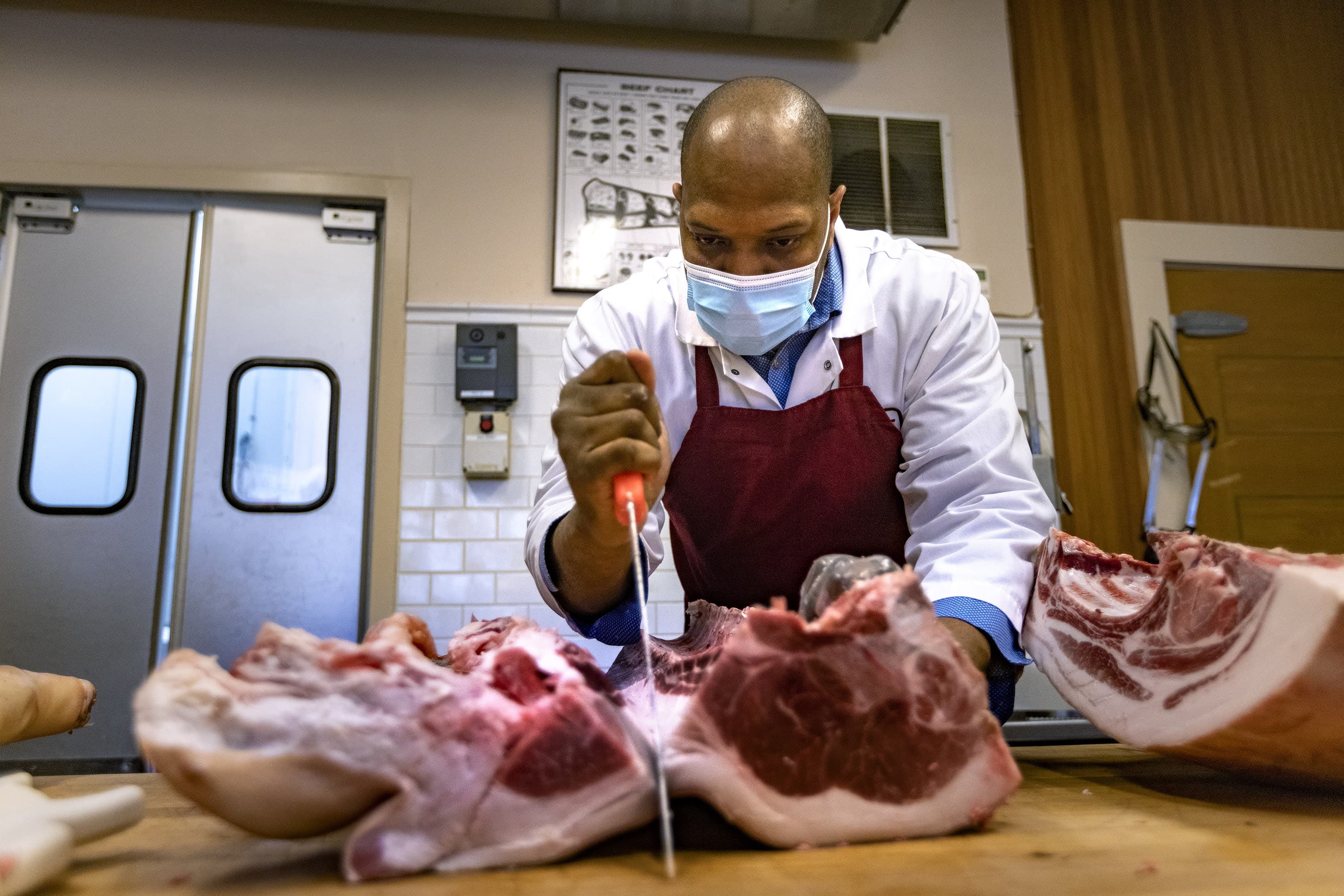Advertisement
Cooked: Is there a place for meat in the search for sustainable eats?

This is an excerpt from WBUR's Cooked newsletter. Sign up to understand how to reduce your impact on climate change and take actionable steps so YOU can make a difference.
Christopher Walker picked up a meat cleaver and swung it down through flesh and bone with a “WHACK.” “That’s where pork chops come from!” He smiled. “That’ll wake you up on a Monday, right?”
You're right it does!
I had come to Savenor’s Market in Cambridge to watch Walker, the general manager, butcher a pig. Actually, half a pig. But it was still pretty huge at about 75 pounds. Walker deftly sliced ribs and roasts while talking about meat for over an hour. With all the talking and cutting I kept expecting him to slice off a finger. (He didn’t.)

Walker told me that most people don’t want to see butchering or a half-butchered animal. They want to keep their mental image of a cute pig separate from the tasty pork chops.
“It’s just kind of backwards to me,” he said. “It's like saying, ‘I want to eat in the dark.’”
You’ve probably heard that one of the best ways to green up your diet is to stop eating meat, especially beef. But maybe you really like burgers and steak tacos, or your family has this amazing barbecue every summer, so you’ve been trying to not think about meat and climate.
But Walker's right. Let’s not eat in the dark! It’s weird — and I’ll probably spill something.
Don’t worry; I’m not going to tell you to stop eating meat. But let’s have an honest conversation about meat and climate change, and then you can decide what works for you.
Advertisement
To start, let’s take a look at the big picture of American meat consumption and emissions.
The Numbers Tell A Story
- Agriculture amounts to about 10% of total greenhouse gas emissions in the U.S. – pretty small potatoes overall, and well behind transportation (27%) and electricity (25%).
- However, farm animals are the cause of a whopping 36% of all human-generated methane released in the U.S. That makes agriculture one of the largest sources of methane emissions in the country.
- Methane only traps heat for about a decade after it’s released into the sky, but it’s between 25-30 times more potent than carbon dioxide. So, reducing methane is a useful short-term strategy to slow climate change quickly.
- 82% of the greenhouse gas emissions in the average American diet come from animal products. (I know you aren’t average, but stay with me here.) Beef accounts for nearly half of those emissions (40%).
- And yet, almost a quarter of Americans say they believe beef does not contribute to global warming at all (23%).
- 81% of Americans say they prefer meals with meat and/or dairy (Mmmm cheeseburgers). However, one economist found Massachusetts was among the states with the least demand for meat.
- The USDA projects only a slight increase in per capita red meat and poultry consumption in the U.S. by 2030.
- If we Americans keep eating like we’re eating, our food-related emissions will increase 9% by 2030, just because there will be more people.
Deep Dive: The Beef With Cows
Cows are amazing! Their gigantic, complicated stomachs can digest grass, changing something humans can’t eat (grass) into food we can (beef and milk). This is especially handy in New England, where animals can graze on land that’s otherwise not-so-great for farming.
All beef cattle in the U.S. are raised on pasture for most of their lives, but about 95% spend their last months eating grain (traditionally corn) on feedlots. This fattens cattle quickly, but can give them stomach pain, liver abscesses and other health problems. Feedlot cattle, like other animals raised in small spaces, often require antibiotics to stay healthy.
At Appleton Farms in Ipswich, Massachusetts, beef cows are raised on pasture only, for their whole lives. This leads to happy cows and healthy pastures; the cows fertilize the soil with their pee and poo, keep the fields clipped and eat invasive species. The healthy soil also stores carbon, and the fields make a home for bees and bobolinks.
This type of farming — plants and animals coexisting in a well-functioning ecosystem that enriches the environment and provides food for humans — is called “sustainable” or “regenerative” agriculture.
Sounds great. What’s the problem?
While digesting all this grass, cows burp out methane. (They also fart methane, but way less.) And, on industrial beef and dairy farms, lagoons of manure also give off methane.
Here’s the thing, folks: pasture-raised cattle use more land and produce more methane than grain-finished cattle. That's mostly because the animals live longer, thus burping and pooping more. And while the carbon stored in the happy meadow reduces some of the carbon footprint of grass-fed beef, counting that carbon storage is still an emerging science. (Yeah, BP came up with the “carbon footprint” term, but it's the best lingo we have to compare emissions.)
Conventional U.S. farmers have also gotten really good at producing beef efficiently. Bigger cattle raised in a shorter time and a smaller space ain't pretty, but it means fewer methane emissions. Researchers and farmers are trying to reduce them further:
- There’s a team of New England scientists looking for the perfect seaweed to feed to cows to reduce the methane in their burps. (Yes, this is a thing.)
- And some farms are starting to capture methane from manure lagoons and use it as fuel.
But “efficiency” has consequences. There are a lot of problems with conventional beef, like antibiotic resistance, overcrowded animals and water pollution. And there are a lot of good things about locally-produced, sustainably-raised meat. It uses less water, supports your community's economy, increases ecosystem biodiversity and protects farmland from development.
Still, to produce the same amount of grass-fed beef America is eating now, we’d need a lot more cattle and a lot more grassland.
THE BIG TAKEAWAY:
Local, pasture-raised beef won’t save us from climate change. Ultimately, we should eat less meat.
4 Ways To Eat Meat More Thoughtfully
1. Before buying meat, ask where it’s from and how it was raised.
Meat raised in New England is often — but not always — more sustainable than meat raised elsewhere. Christopher Walker was butchering a pig from Vermont Heritage Grazers, a small sustainable farm where the pigs run around eating local grain and upcycled whey from Stonyfield Farms. But you can’t assume that local = sustainable, so you need to ask or look online.
2. Swap out beef for other meat.
A 2022 study found that swapping out beef for chicken (or almost anything, really) for one meal a day dropped a person’s dietary carbon footprint for that day by up to 48%.
“That’s pretty significant,” study author Diego Rose, a professor of food and nutrition policy at Tulane University, told me. “You don’t have to become a vegetarian … if you've been eating beef a lot and you can just cut back on how much you're eating, that would make a big impact.” (You can read my full Q&A with Rose here.)
3. Don't be cheap about your meat. Just buy (and eat) less of it.
Somewhat surprisingly, a lot of climate-conscious beef farmers are on board with this. Appleton Farm’s former livestock manager Aaron Knight told me that he considers beef an “expensive protein,” and says consumers should think carefully about how much they eat and how often.
Or as butcher Walker put it: “When you want the 99 cent meat, that's when it becomes a problematic situation.”
4. Or go ahead, be cheap about your meat! Buy sustainable but less popular cuts.
Sustainably raised meat can easily cost four times more than the styrofoam-and-plastic wrapped packs at the grocery store. If you want sustainable meat, but don’t want to pay $13 for a pork chop, try stew meat or pork shanks.
Butcher Judy Yao suggests this recipe for braised pork shanks from Savenor’s.
